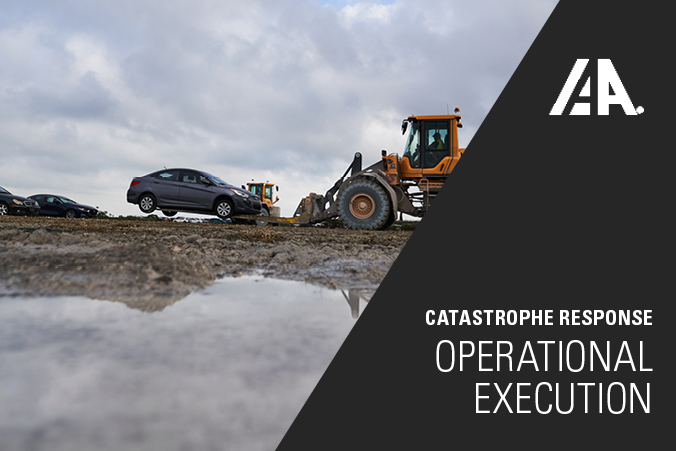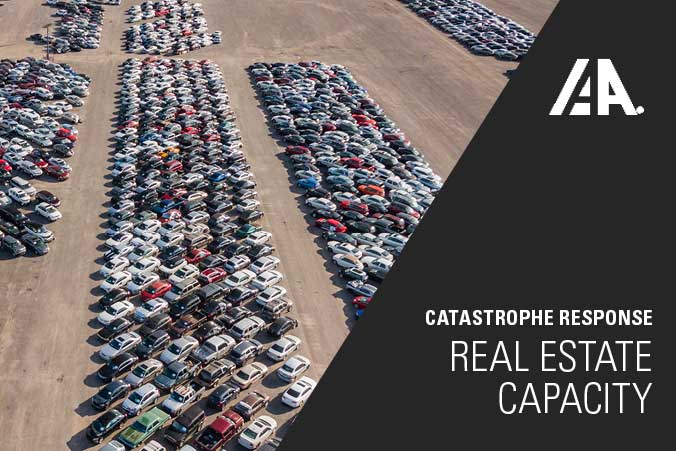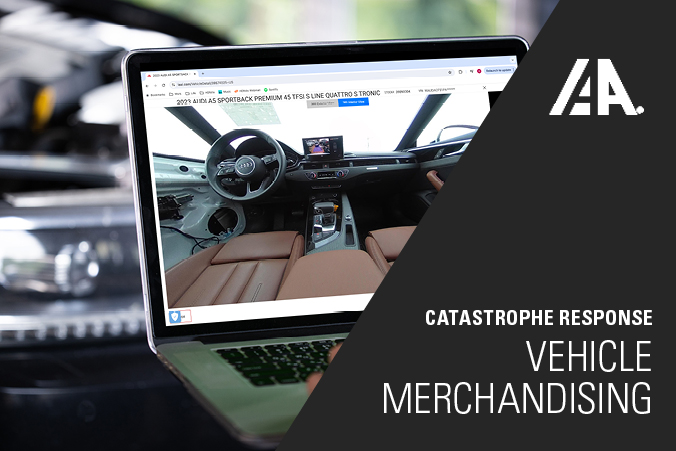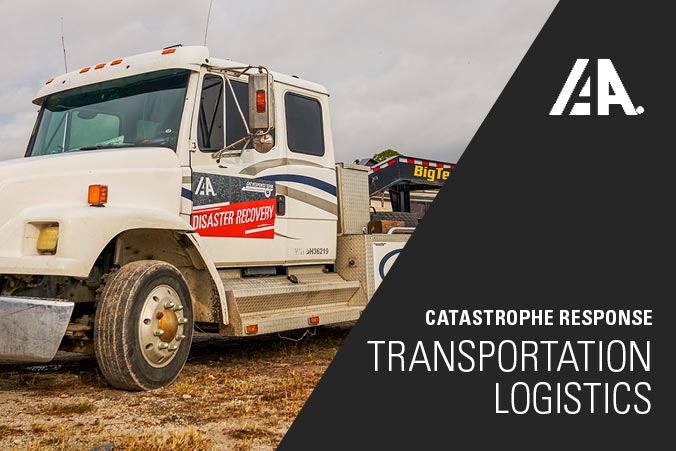Catastrophe Response
IAA Catastrophe Response Strategy: Operational Execution
Published June 7, 2024 - Written by IAA, Inc.
7 Min read
Summary
IAA’s Catastrophe Response Strategy is sound and scalable, enabling us to respond to the unpredictability, size and frequency of any weather event, including having exceptional operational execution to handle each CAT event.
Overview
When the unexpected happens, a swift recovery is critical to ensure business continues and communities get back on their feet. IAA’s Catastrophe Response Strategy is sound and scalable, enabling us to respond to the unpredictability, size and frequency of any weather event. Because these catastrophe events, such as wildfires, hurricanes and tornadoes, have many shifting variables, a proactive yet flexible process is necessary to ensure a timely and appropriate response.
IAA’s Cat
astrophe Response Strategy provides an unmatched level of service to our customers in their greatest time of need. It comprises four key areas: Real Estate Capacity, Operational Execution, Transportation Logistics and Vehicle Merchandising.
Here, we dive deeper into Operational Execution.


Catastrophic weather events present complex, unpredictable challenges that can have dramatic last-minute implications on where and how operations ultimately take place. Getting the right levels of personnel and equipment delivered to the right locations at the right times, under constantly changing conditions, is crucial and requires considerable planning and resources.
IAA’s Operational Execution strategy rests on a team-centric approach, leveraging five key elements: Preparation and Teamwork; Partnership and Prediction; Procurement; Yard Organization; and Client Support and Communication. To ensure a strong, safe and efficient catastrophe response, IAA assembles highly trained and prepared teams that have a sole focus on catastrophe operations. They’re armed with industry-leading planning tools, weather and logistical data, and state-of-the-art equipment. The result is a catastrophe management discipline that is unmatched in the industry and has a long history of exceeding our customers’ expectations.

Preparation & Teamwork
A seamless Catastrophe Response process is only as good as the people implementing it. Our multi-layered approach to staffing CAT recovery gives us the ability to scale up or down in accordance with the needs warranted by the event.
Dedicated CAT Response Team
This team is charged with year-round preparation and testing to be ready as first responders when an event occurs. Staffed with CAT response experts, Operations Managers, Assistance, Transportation and Logistics leadership, and Human Resources and Procurement personnel, this team has the ability to begin coordination of every facet of response at a moment’s notice.
Regional Flex Team
Another set of first responders staffed with Operations and Transportation personnel, these teams are regionally based and activated when an event hits their region.
Call Centers
IAA’s centralized contact center model, with redundant capability across multiple sites, provides the advantage of scalable resources to process catastrophe vehicle assignments around the clock. Our contact center teams utilize structured labor management systems that deploy appropriate resources to handle volume spikes caused by catastrophes. When demand increases, our centralized contact centers can quickly scale to meet the increased demand.
Additional Staffing for Large Events
Each year, IAA recruits CAT volunteers within the employee base who are ready and available to provide additional support should an event be large enough to warrant it. These volunteers are thoroughly trained for response and are available to cover any part of the response effort. IAA also works with a variety of contracted third-party resources that augment staffing for vehicle inspections to ensure vehicles coming in are inspected and processed quickly.
RB Global Resources
Additional land and personnel are provided by RB Global. Similar to IAA, RB Global volunteers are ready to respond to CAT events, and RB Global’s additional land capacity helps to ensure all levels of CAT volume is accommodated.
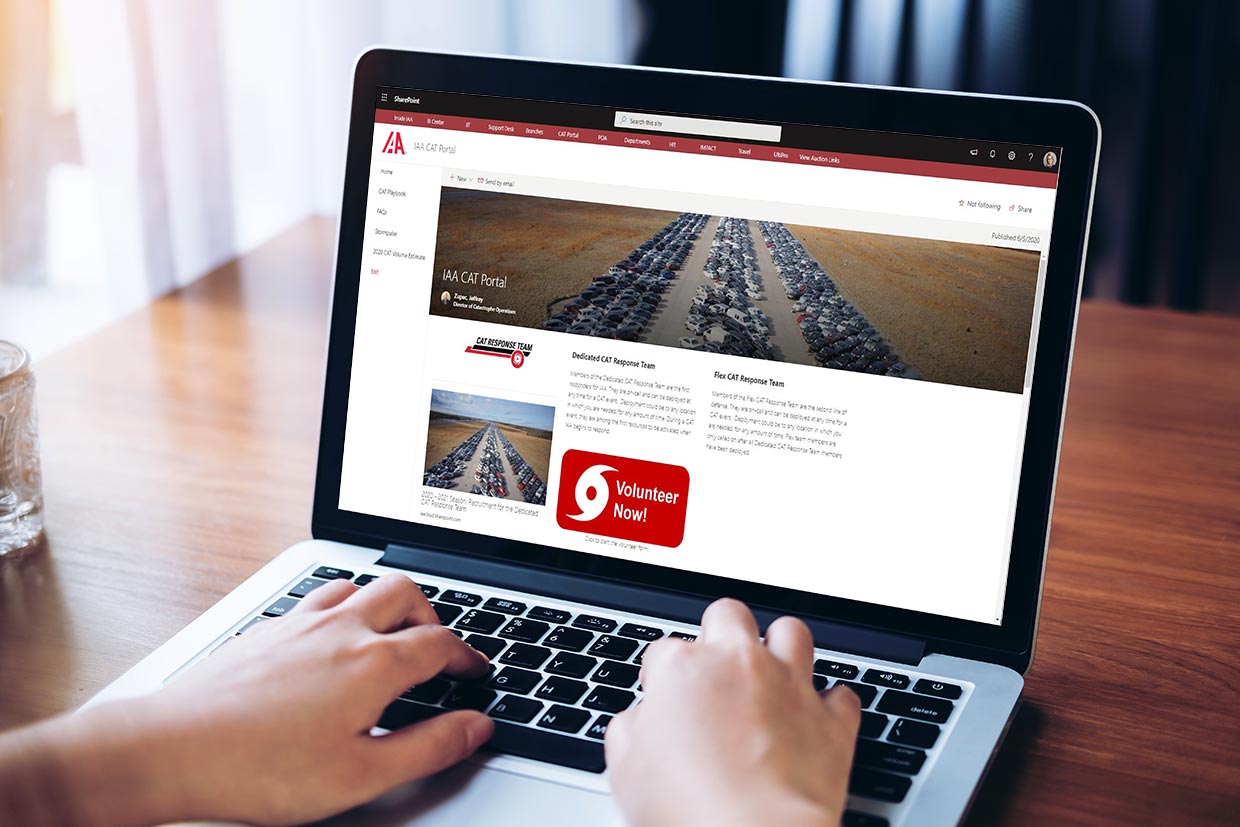
Partnership & Prediction
Partnerships with insurance providers and state and local emergency management agencies are a critical operational element to our successful CAT response. For 40 years, IAA has focused on creating consistent communication and collaboration with federal, state and local level emergency management agencies. This effort has resulted in IAA’s active participation as a first responder in state catastrophe conferences each year. In addition, relationships with emergency management agencies provide IAA with critical information during a catastrophic weather event, including road-closure notifications that enable us to operate efficiently.
During severe weather season, our Catastrophe Operations Team closely monitors all weather-related activity in the Atlantic Ocean, Pacific Ocean, Gulf of Mexico and Caribbean. We monitor weather forecasts, models and potential impact zones as storms move across the globe. IAA utilizes nearly 10 different forecast services to monitor weather movement. Each day, a weather activity report is generated and reviewed to determine if or when to activate IAA’s Catastrophe Response Strategy. We monitor specific categories of weather events, including hurricanes, significant rainfall/floods, tornadoes, hailstorms, blizzards and earthquakes.

Procurement
IAA works diligently to procure, maintain and deliver the equipment required for operational execution. Each offseason, IAA invests in updating hardware, software and equipment to be prepared and available to service catastrophe sites. Our state-of-the-art command centers and mobile trailer fleet allow us to deploy operation center assets where needed in the U.S.
IAA branches located within 100 miles of catastrophe-prone areas securely house catastrophe equipment, devices and PPE. Stored devices include handhelds, laptops, printers, and tablets. This equipment is stored in rooms designed to protect and power all devices and ensure up-to-date device software. Equipment, including loaders, lights, etc., designated for Catastrophe Operations are located within 100 miles of areas prone to severe weather.
Our Catastrophe Team includes a dedicated procurement resource who sources and secures any needed additional equipment ahead of a storm when landfall is likely. This enables the team to have all necessary equipment on location.

Yard Management & Organization
Catastrophe Operations can work 24 hours per day, seven days per week, depending on size and severity of the event. IAA utilizes a labor-management discipline to ensure appropriate staffing across catastrophe operations in compliance with all applicable rules and regulations. There is an established Catastrophe Operations Center housed at an IAA branch location that acts as the hub of all activity and connects all additional storage locations. Hired security provides around the clock surveillance of assets, allowing transportation operations to operate 24-7.
IAA takes a customer-focused, smart approach to organizing its branches and storage yards during catastrophe events. The key goals are to ensure well-planned yard flow and accessible vehicle inventory. IAA leverages its branch inventory organization model in catastrophe storage yards. This translates to catastrophe storage facilities having easy entry and exit designs, locations near highways, safety for appraisers/adjusters, and vehicle organization that is in alignment with customer needs.
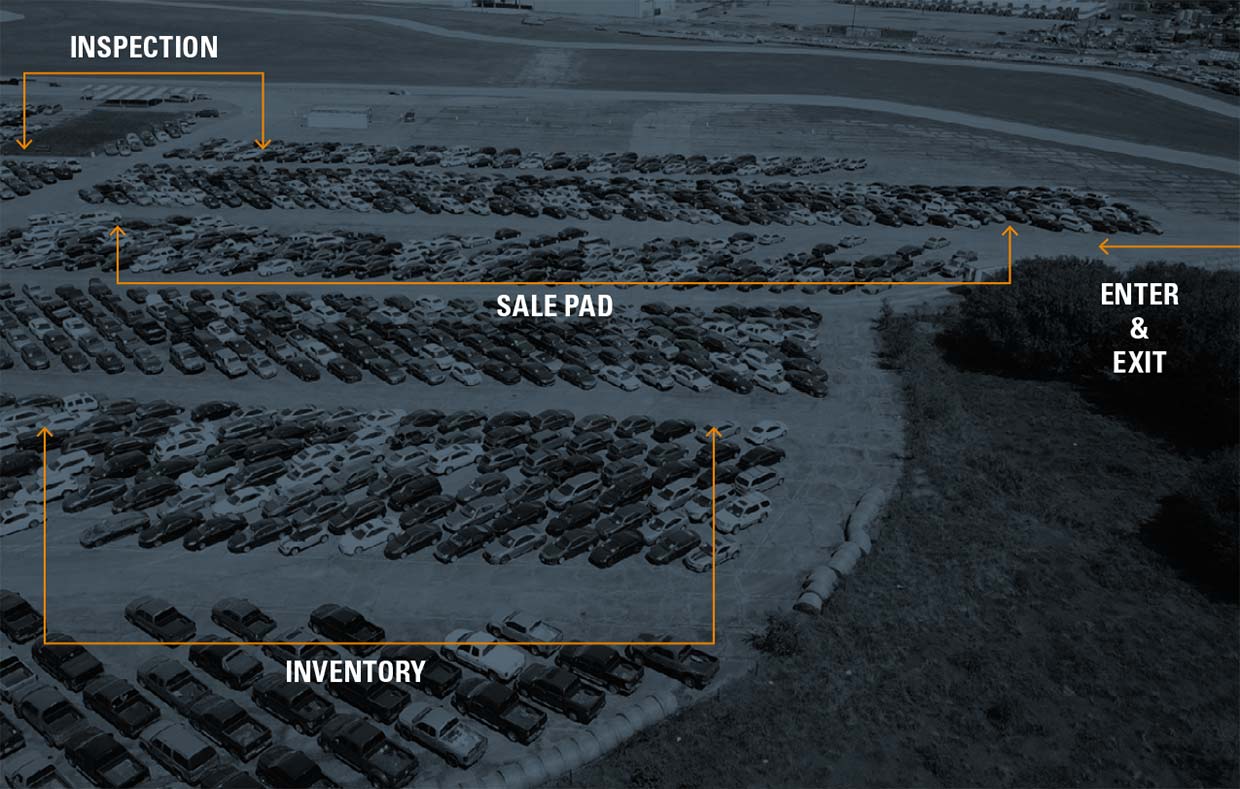
The location of yards, the organization of vehicles, and the accessibility to customer assets is critical to provide an efficient response process. Storage yards need to be close to the actual event to minimize the time required to transport vehicles, and to decrease travel time incurred by/spent by adjusters and appraisers. IAA uses their standard vehicle storage structure and spacing within catastrophe storage yards to ensure adjusters can perform their duties safely and efficiently.
IAA has a fleet of mobile catastrophe trailers that act as the hub of operations for remote storage yards. These units are agile, easily moved, and designed to fully manage operations from a storage facility. The foundation of our catastrophe response strategy focuses on flexibility given the unpredictable nature of weather events. Large trailer units or big temporary structures are difficult to move and serve little purpose in events spanning several miles or in large metropolitan areas like New York and Houston. In the wake of Hurricane Dorian in 2019, IAA’s mobile fleet proved essential. The storm had the potential to make landfall in nearly 12 different locations and traveled over 980 miles between Deerfield Beach, FL, and Hatteras, NC, where it made landfall. Due to our fleet’s ability to be mobile, we were able to follow the path of the storm and ultimately provided catastrophe services to our clients affected in North Carolina.
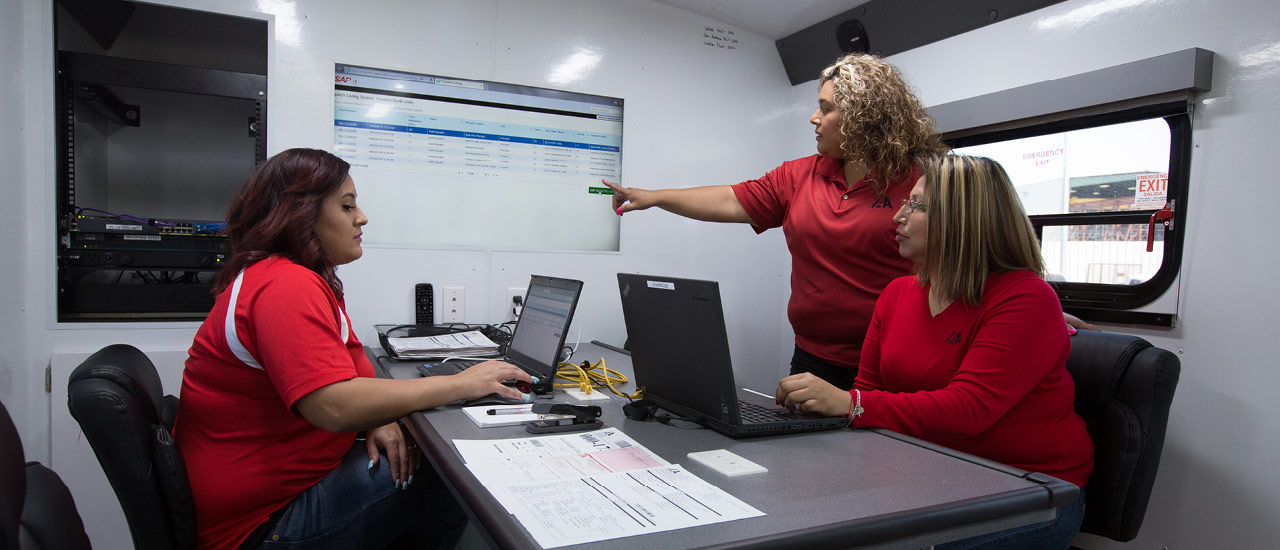
Client Support & Communication
Weather events can create a dramatic increase in vehicle volume for IAA. This additional volume then creates a greater need for IAA Title Services. To manage the additional demand, IAA has increased staff working space at its title centers in catastrophe-prone locations. These centers then can quickly and efficiently bring in additional staff from across the IAA organization and immediately get to work. IAA’s suite of services can dramatically reduce the cost and cycle time associated with the titling process. The value of these services is particularly critical after the influx of vehicles from a catastrophic event.
Throughout each CAT event, IAA makes customer and employee communication a priority. When tracking a storm, IAA summarizes storm conditions, movement and speed, and provides up-to-date information regarding our catastrophe response. Once landfall is certain, communication frequency increases to provide essential information about storage locations, staffing, towing and logistics, equipment, human resources, area accessibility and local municipality details. IAA also provides dynamic information on its catastrophe response website page – accessible anytime, anywhere to our clients.

Each catastrophe communication sent to our clients takes into consideration the following areas:
Account Management/Customer Support
Human Resources
Marketing/Communications
Operations on the ground
Procurement
Real Estate
Safety/Security
Transportation
Travel Coordination
IAA Operational Execution: Competitive Advantages
IAA has consistently delivered the industry’s leading CAT service and response in all events that have occurred since Hurricane Sandy in 2012.
IAA leads the industry in understanding and meeting customer needs around CAT events. We are continually seeking customer input before, during and after a weather catastrophe. We understand that each customer and event is unique and take a customer-focused approach in everything we do.
IAA is a learning organization and is constantly working to grow from previous events. Our continuous improvement mindset means our customers benefit from every CAT-related experience the organization has managed. That helps improve every aspect of our industry-leading CAT response, increasing the customer’s efficiency, safety, proceeds, and satisfaction.
The entire IAA organization understands the critical importance of treating our customer’s customer as our own [as if they were our own]. IAA’s Account Management Team ensures every provider’s customer receives fast, courteous treatment from across the organization. The high degree of expertise and experience found in CAT Response Team members support IAA’s superior customer focus.
IAA’s personnel are a significant differentiator in its CAT response. They are highly trained, highly experienced CAT professionals who are dedicated and passionate about meeting customers’ needs.
Operational Execution alone cannot manage a catastrophe. IAA’s Catastrophe Response Strategy consists of four components, including Operational Execution, Transportation and Logistics, Real Estate Capacity and Vehicle Merchandising – an unmatched portfolio of capabilities.
Forward-Looking Statements
Certain statements contained in this release include “forward-looking statements” within the meaning of Section 27A of the Securities Act of 1933 (the “Securities Act”) and Section 21E of the Securities Exchange Act of 1934 (the “Exchange Act”) and Canadian securities laws. Forward-looking statements are typically identified by such words as “aim”, “anticipate”, “believe”, “could”, “continue”, “estimate”, “expect”, “intend”, “may”, “ongoing”, “plan”, “potential”, “predict”, “will”, “anticipates”, “should”, “would”, “could”, “likely”, “generally”, “future”, “long-term”, “foresees”, “estimates”, “opportunity” or the negative of these terms, and similar expressions intended to identify forward-looking statements. Forward-looking statements are based on current expectations and assumptions that are subject to risks and uncertainties that may cause actual results to differ materially. These statements are based on our current expectations and estimates about our business and markets, and may include, among others, statements relating to IAA’s Catastrophe Response Strategy, our future strategy, objectives, targets, projections and performance and other statements that are not historical facts. It is uncertain whether any of the events anticipated by the forward-looking statements will transpire or occur, or if any of them do, what impact they will have on the results of operations and financial condition of the combined companies or the price of RB Global’s common shares. Therefore, you should not place undue reliance on any such statements, and caution must be exercised in relying on forward-looking statements. While RB Global’s management believes the assumptions underlying these forward-looking statements are reasonable, these forward-looking statements involve certain risks and uncertainties, many of which are beyond RB Global’s control, that could cause actual results to differ materially from those indicated in such forward-looking statements, including but not limited to: our results of operations, strategy and plans; potential adverse reactions or changes to our business or employee relationships; our ability to integrate acquisitions (including IAA, Inc. ), the diversion of management time on transaction-related issues; the ability of RB Global to retain and hire key personnel and employees; the significant costs associated with the merger; the outcome of any legal proceedings that could be instituted against RB Global; changes in capital markets and the ability of the company to generate cash flow and/or finance operations in the manner expected or to de-lever in the timeframe expected; the failure of RB Global to meet financial forecasts and/or KPI targets; legislative, regulatory and economic developments affecting the business of RB Global; general economic and market developments and conditions; the evolving legal, regulatory and tax regimes under which RB Global operates; unpredictability and severity of catastrophic events, including, but not limited to, pandemics, acts of terrorism or outbreak of war or hostilities, as well as RB Global’s response to any of the aforementioned factors. Other risks that could cause actual results to differ materially from those described in the forward-looking statements are included in RB Global’s periodic reports and other filings with the Securities and Exchange Commission (“SEC”) and/or applicable Canadian securities regulatory authorities, including the risk factors identified under Part I, Item 1A “Risk Factors” in RB Global’s most recent Annual Report on Form 10-K for the year ended December 31, 2023. The forward-looking statements included in this release are made only as of the date hereof. While the list of factors presented here is considered representative, no such list should be considered to be a complete statement of all potential risks and uncertainties. Many of these risk factors are outside of our control, and as such, they involve risks which are not currently known that could cause actual results to differ materially from those discussed or implied herein. RB Global does not undertake any obligation to update any forward-looking statements to reflect actual results, new information, future events, changes in its expectations or other circumstances that exist after the date as of which the forward-looking statements were made, except as required by law.
